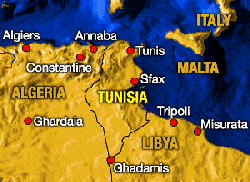

|



 Tunisia
Tunisia

|
Directory Information
|
Libraries in Tunisia were founded in great number, especially during the Aghlabid and Fatimid ages (800-1171) when they were located in mosques and also in schools. Among the most famous libraries are the lbdilliyya Library (1393), the AlAhmadiyya Library (1840), and the Sadiqiyya Library (1885). Before independence in 1956, library services were administered by cultural institutions such as the Khalduniyya Library (1909) and Al-Lakmiyya library in Sfax (1931). There are also a limited number of foreign libraries, notably that of the British Council (1943) and the Library of the American Cultural Center (1948).
The concept of modern library service emerged after independence in 1956. Libraries were given greater attention, and since 1963 the persistent need for raising the standard of library services moved the authorities to plan for libraries in the "Fourth Plan: 1972-1976. " As a result of the Fourth and Fifth Plans, several types of libraries are found in Tunisia.
National Library
Known as the French Library and later as the Public Library, the National Library in Tunis was established by law in 1885 under French government sponsorship. Its collection was gathered in individual sporadic efforts and by gifts.
The concept of Dir Al-Kutub Al-Wataniyya, the National Library, however, emerged only after independence in 1956. In 1970 the Tunisian National Library published the first issue of the Tunisian National Bibliography, a booklet covering the first period in 1969. From then on the National Library has tried to fulfill the enormous task of publishing current and retrospective bibliographies at the same time, ensuring the link between the past and the present and tracing every single document produced in the area from the introduction of printing in Tunisia (1881) up to independence. By 1983, 13 bibliographies had been issued covering the years from 1956 through 1982.
The Tunisian National Bibliography is issued quarterly with an annual cumulation. It covers all documents published in Tunisia and deposited at the National Library. These documents include government and nongovernment publications, university theses, textbooks, and new periodicals. Nonbook material is not covered. The National Library also compiles current bibliographies on special Tunisian and Arabic subjects.
The National Library's collection of manuscripts, which includes some that date from the 5th century, totals 25,000. The National Library also has a collection of about 10,000 current periodicals, more than two-thirds of them in Arabic.
The Library's collection reached about 750,000 volumes by 1984. It suffers from lack of space for users. It serves about 27,000 users a year, even though the number of seats is just 160. The collection is primarily in Arabic and French, but there are considerable holdings in English, and volumes are collected in 12 languages.
The National Library is a depository for Tunisian publications and has an accession rate of about 10,000 volumes a year. The Library's Documentary Department is responsible for legal deposit, but it did not officially have copyright deposit privilege in the mid-1980s.
In December 1984 the government started building a modern library to serve as a National Library. Modern processes and operations will be used for computer applications, nonbook materials, and bibliographic and other services.
Tunisia is one of the few African countries to have an International Serials Data System (ISDS) national center.
Sources:



|